 |
Telling Time
|
 |
Telling Time
|
Introduction
How would we measure time without a clock? We know that
the Sun moves across the sky during the day. Can we tell what time it is by looking at the position of the Sun?
In modern times, precise time measurement is very important. So many people depend on knowing the "right time" to go about their daily business. Industrialized societies need accurate regular time measurement to function. Does everyone on Earth live in such a society? No, in some parts of the world people still live much as they did thousands of years ago. Even our
industrialized societies are fairly new when compared to most of human existence. Only a few hundred years ago telling time exactly wasn't so important. But it was still helpful to get a rough idea of what time it was.
Pointing at the Sun
Probably the simplest way to tell time is by knowing the path of the Sun across the sky and how long it takes the Sun to move. Where on Earth is this method easiest? If the Sun rises high in the sky and its path doesn't change much from season to season, it is pretty easy to tell time from the position of the Sun. The Sun behaves more like this the closer to the equator one gets. Many pre-industrial peoples in the tropics used this method of telling time, even into this century. Many African peoples--such as the Cross River, Caffres, Waporogo, and Wagogo peoples--would indicate time by pointing to a place in
the sky where the Sun would stand at the time they wished to indicate. The same method was used in other parts of the world, such as the New Hebrides, Dutch East Indies, and Sarawak.
What about telling the time of the Sun in regions farther north or south of the equator? The Sun's path changes much more over the course of the year as one moves farther from the equator. In winter the Sun might be very low while in summer it might be much higher.
One simple way to tell time was to divide the daylight time and the night time into segments. Many cultures did this, using different numbers of segments. For example, the Chinese divided one sun-cycle into 12 sections and the Hindus into 60. Very early on, the Egyptians divided the period between sunrise and sunset into 10 sections, an
d then added two more sections for the periods of twilight at dawn and nightfall--making 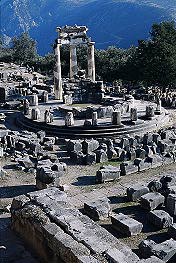 12 sections of daylight time. They then divided the night into 12 sections also. This made a division of the sun-cycle into 24 sections, very much like the 24 hours that we divide the sun circle into. The Babylonians used a similar system, and this is in fact where our modern 24-hour day has its origin.
1
12 sections of daylight time. They then divided the night into 12 sections also. This made a division of the sun-cycle into 24 sections, very much like the 24 hours that we divide the sun circle into. The Babylonians used a similar system, and this is in fact where our modern 24-hour day has its origin.
1
However, there was an important difference between the hours we use and the "hours" of the Babylonians and the Egyptians. Their "hours" changed length, depending on what time of the year it was! They divided both daylight and nighttime into 12 sections each. When the daylight lasted a long time during the summer, their daylight "hours" could be as long as 75 minutes, while the nighttime "hours" were only 45 minutes long. In winter, however, when the Sun was not up as long, their "hours" might shrink to as short as about 55 minutes during the day, while at night they were about 70 minutes. Only on the equinoxes were their "hours" 60 minutes, both day and night, just like our modern hours. You can imagine what trouble using a system like this would cause in the modern world, as the length of the hours changed slightly each day of the year!
The ancient Greeks had borrowed the Babylonian/Egyptian system of counting hours, but in the late second century BCE, over 2100 years ago, a
Greek astronomer called
Hipparchos suggested that the "equinoctal hours" of 60 minutes each for use at all times of the year. This is where our modern system ultimately comes from, but it was a long time before it became widely used. The Greeks (and Romans) continued using the Babylonian/Egyptian system of "temporal hours" which changed length through the year for thousands of years, and many European peoples adopted this usage as well. In 725 CE, the English monk Bede wrote a highly influential book on time-keeping. Most importantly, it helped popularize the modern Western system of counting years (AD/CE and BC/BCE), but in it Bede also argued for dividing the sun-cycle into 24 equal hours at all times of the year. Nevertheless, it was not until mechanical clocks started to become common during the 1300s that the "equal hours" began to replace the "temporal hours" for good.
The Egyptians, Babylonians, Greeks, and Romans all lived far enough north of the equator that they could not rely on a fairly constant Sun-path over the year, as people in the tropics did, but they were not so far from the equator that the differing lengths of day and night made it difficult for them to use their "temporal hours", even though their lengths changed somewhat over the course of the year.
Very far north (or south) of the equator, however, the difference between the length of
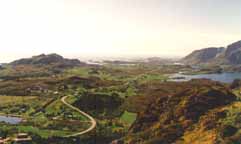 daylight time in the summer is very much greater than in the winter. In parts of
Scandinavia above the Arctic Circle (at a latitude of 66.5° North) the Sun does not set at all for part of the summer--it is daylight all the time. On the other hand, for part of the winter the Sun does not rise in these same areas. Obviously there is no point in dividing the daytime or nighttime into twelve sections if they are not taking place! Even if the Sun sets for only three of our modern hours in the summer, if one is dividing the daytime and nighttime into Babylonian/Egyptian-style "temporal hours", the nighttime hours will be so short compared to the daytime hours that there is hardly any point in making the divisions.
daylight time in the summer is very much greater than in the winter. In parts of
Scandinavia above the Arctic Circle (at a latitude of 66.5° North) the Sun does not set at all for part of the summer--it is daylight all the time. On the other hand, for part of the winter the Sun does not rise in these same areas. Obviously there is no point in dividing the daytime or nighttime into twelve sections if they are not taking place! Even if the Sun sets for only three of our modern hours in the summer, if one is dividing the daytime and nighttime into Babylonian/Egyptian-style "temporal hours", the nighttime hours will be so short compared to the daytime hours that there is hardly any point in making the divisions.
However, even very far north (or south), no matter where the Sun rises or sets, the middle of its path is above about the same part of the horizon. That means you can always tell when the middle of the day is if you know above which point on the horizon the highest point of the Sun's path is. Also, no matter how high the Sun is above the horizon, it always passes over the same points on the horizon after the same interval of time. Using these facts, the people living in Scandinavia developed a system of time-keeping quite different than the Babylonian/Egyptian system.
As said earlier, our modern system of time-keeping divides each sun-cycle
 into twenty-four hours, each of which is 60 minutes long. The Scandinavians divided each sun-cycle (sólarhringr, "sun-ring" in their language) into eight sections.
2
They did this by dividing the horizon into eight sections (north, northeast, east, southeast, south, southwest, west, and northwest). Each of these sections was
called an eighth (átt or eykt).
3
A place on the horizon
which lay dead center in any of these eight directions (due north, due northeast, etc.)
was called a daymark (dagmark).
4
The identified the time by noting when the Sun stood over one of these daymark-points on the horizon.
into twenty-four hours, each of which is 60 minutes long. The Scandinavians divided each sun-cycle (sólarhringr, "sun-ring" in their language) into eight sections.
2
They did this by dividing the horizon into eight sections (north, northeast, east, southeast, south, southwest, west, and northwest). Each of these sections was
called an eighth (átt or eykt).
3
A place on the horizon
which lay dead center in any of these eight directions (due north, due northeast, etc.)
was called a daymark (dagmark).
4
The identified the time by noting when the Sun stood over one of these daymark-points on the horizon.
The Midday Daymark
What do you think the most important daymark was? It was the daymark beneath
the highest part of the Sun's path, since the Sun reaches the highest part of its path above the same part of the horizon every day of the year. This central daymark was named Highday or Midday (hádegi or middag). That was the name of the time, just as we would say
"twelve o'clock" or "noon". The position of the Sun at this time had its own related name: Midday Place (hádegistað or middagsstad).
5

Many, perhaps most, Scandinavians lived in isolated farms or villages in earlier times. They used geographical features located on the horizon (as viewed from near their homes) as guides to the daymarks. Often they would name a feature, usually a mountain, after the daymarks. Since Midday was the most important daymark, there were many mountains named after it: Middagsfjället, Middagshorn, Middagshaugen, Middagsnib, Middagsberg, and Middagsfjeld are all mountain names in Norway--similarly Sweden has Middagsberget and Middagshognan, while Iceland has a Hádegisbrekkur. All of these names are made by taking the Scandinavian words for Midday (or Highday) and adding a Scandinavian word meaning "mountain". They are like saying "Mount Midday" or "Midday Mountain" in English.
The Other Daymarks
Midday was the most important daymark, since it divided the Sun's path in half, but there were seven other daymarks in all, and each of these had names, too. Some of these daymarks took place during the night when the Sun was below the horizon. Because Scandinavia was so far north, during the winter the Sun could be below the horizon most of the time! But when the Sun is not very far under the horizon and the weather is clear, it is still possible to see it's light showing where the daymark is on the horizon.
What is the opposite of Midday? It is Midnight. Just as we have a name for the middle of the night in English, the Scandinavian's had a name for the daymark
in the middle of the night: miðnætti. It is very easy to find a Midnight daymark in the summer in Scandinavia. Although the Sun often does set for a while at night, the twilight is often bright enough to mark the spot on the horizon which the Sun is beneath. In some parts of Scandinavia the Sun simply
does not set in the middle of summer! Then one need only look for the lowest point
in the Sun's path, and mark the spot on the horizon beneath it. Just as the Sun reaches its highest point (Midday) at due south, it reaches its lowest point (Midnight) at due north.
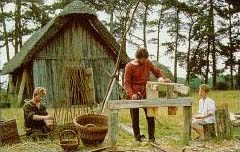
Between Midday and Midnight are three more daymarks. The first is called Undorn or simply eykt. The names for this daymark are hard to translate into English. Their origins were lost long ago, and even the ancient Scandinavians may not have known exactly where the names came from--only that they referred to this time of day in the afternoon. 6 After the Scandinavians were converted to Christianity, they sometimes used the name nón for this time, borrowed from the Latin term hora nona, which means ninth hour--the Roman people, who spoke Latin, had considered the ninth hour of the day to happen in the afternoon (clearly they started counting their hours at a different time (6 a.m.) than we do now!). 7
After undorneykt (or nón) comes Mid-Evening (miðr aptann). At Mid-Evening, the Sun is approximately due west--or halfway between the Midday (south) and Midnight (north) daymarks. On the equinoxes the Sun would set right at the Mid-Evening daymark. Before Midnight, there was one more daymark called Night-Measure (náttmál). 8
Between Midnight and Midday there are three more daymarks, making eight in all. Midnight was followed by Ótta. This name comes from an very ancient Germanic root-word, *uhtwón, and designated the time of night before daybreak, which was thought the deepest and most frightening time of night. 9 Even during summer, the sky would darken a little at this time in many parts of Scandinavia. In winter, Ótta must have seemed very dark indeed!
Mid-Morning (miðr morgun) took place when people
woke up in the morning.
10 Most of the daymarks were determined by events
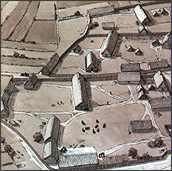 in daily life like this. Since the Sun rose so early in summer, it might have been light long before people finished sleeping. On the other hand, in winter, the Sun might not rise until long after people woke up. In a way similar to that of Mid-Evening, the Sun at Rise-Measure is approximately due west, halfway between the Midnight (north) and Midday (south) daymarks. On the equinoxes the Sun would rise right at the Rise-Measure daymark. Before Midday there was one more daymark called Day-Measure (dagmál)--just as Night-Measure came before Midnight.
in daily life like this. Since the Sun rose so early in summer, it might have been light long before people finished sleeping. On the other hand, in winter, the Sun might not rise until long after people woke up. In a way similar to that of Mid-Evening, the Sun at Rise-Measure is approximately due west, halfway between the Midnight (north) and Midday (south) daymarks. On the equinoxes the Sun would rise right at the Rise-Measure daymark. Before Midday there was one more daymark called Day-Measure (dagmál)--just as Night-Measure came before Midnight.
These other daymarks did not seem to be as important as Midday, but sometimes we find geographical features named after these daymarks, just as we found them named after the Midday daymark: in Norway we find Rismaalsfjeld and Nonsfjeld, in Sweden we find Nonsberget and Nonsknätten. In Iceland are Dagmálahóll, Eyktargnipa, Nónfell, Miðaptansdrangur, and Undornsfell. Around a thousand years ago many Scandinavians settled in England, and they used some of these same naming traditions at their new English farms. Thus, there are some more daymark-type place names in the parts of England where they settled.
| On the right is a view of a Scandinavian farm from above. In the center is the farm house, and around it are imaginary lines and labels showing in which direction the various daymarks are. The edge of the green circle represents the horizon. Beyond it the Sun is shown standing at the eight daymark points on the horizon. Would the Sun always be
visible at these daymarks? No, sometimes it would be below the horizon and not visible. But even when we cannot see the Sun it is still below the daymark, underneath the horizon at night.
In the summer, when the Sun is up almost all of the time, the Sun appears to travel around the circle in a clockwise fashion. Even at midnight, there may be enough twilight lingering in the north to show where on the horizon the Sun would be. If the farm were far enough north, the Sun might even be visible above the horizon at midnight during the middle of the summer. In our modern system of telling time, if the time is halfway between one hour and the next--between 2 p.m. and 3 p.m. for example--we might say it was "half past two". The Scandinavians used a similar system when the Sun stood halfway between two daymarks. In such a case, they would say it was "evenly near both" (jafn nærri bá ðu) daymarks. So if the Sun were between the Midday and Undorn daymarks, they would say, "It's evenly near both Midday and Undorn." |
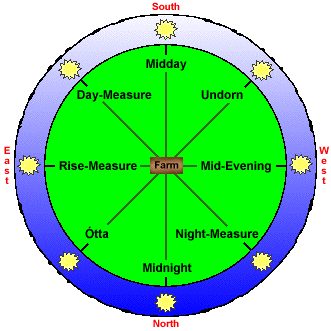
View of a Scandinavian farm from above, showing |
| This diagram, on the right, shows a view south from the same Scandinavian farm, with mountains on the horizon drawn in black.. It shows how the daymarks work, using the Midday daymark as an example. The people living on this farm could watch the Sun's path everyday and find where its highest point was--and
in this diagram the Sun is shown at the highest point in its path. What did the Scandinavians call this place in the Sun's path? They called it Midday's Place (hádegistað or middagsstad).
Conveniently for the people on this farm, there is a large mountain directly beneath Midday's Place which they can use as a daymark. Which daymark is it? It is the Midday daymark. They might name the mountain under the Midday daymark something like "Mount Midday". Then they will know that whenever the see the Sun over Mt. Midday, that the time is "Midday". |

When the Sun is in Midday Place, it is above the |
| On the right is a diagram showing a view from the same imaginary Scandinavian farm. This view shows the Sun's path on the equinoxes, either autumn or spring. The Sun is shown its
positions at Rise-Measure's Place (sunrise), Midday's Place, and Mid-Evening's Place (sunset). The Sun's path is drawn in yellow.
The mountain which marks the Midday daymark is named Mt. Midday. On some farms, the people might find mountains for the other daymarks and name them, too--or they might use other features, like passes, waterfalls, etc. In this diagram, there are mountains named after the Rise-Measure and Mid-Evening daymarks, and their names are in brackets.
|

Equinoctal View of the South Horizon from a Scandinavian Farm |
| Now look at the view from the same farm in summer. Where is the Sun's path now? The Sun is very high in the sky, even when it is over the Rising-Measure and Mid-Evening daymarks! During the summer the Sun's path is longer than it is at the equinoxes and much, much longer than it is during the winter. But no matter how high or low the Sun is in the sky, it still arrives over the daymarks at the same time. This means when the Sun is at its highest point in the winter it is still over the same daymark as in the summer. So when the Sun is over Mt. Midday it means that the time is Midday, whether it is winter or summer. It's highest point during the winter is not as high as its highest point during the summer. | 
Summer View of the South Horizon from a Scandinavian Farm |
| During the summer in Scandinavia, the Sun scarcely ever sets--particularly in the northernmost sections. The diagram on the right shows what a view north from the same Scandinavian farm might look like at Midnight in the middle of the summer. The twilight glow of the Sun is still visible, even though the Sun is below the horizon. This is the lowest part of the Sun's path. At the Midnight daymark on the northern horizon there is a pass--a gap in the mountains--which the people living on the farm might name after the daymark. Perhaps they might call it Midnight Pass, just like they called the mountain to their south Mt. Midday, after the Midday daymark | 
Summer View of the North Horizon from a Scandinavian Farm |
| On the right is a diagram showing a view from the same imaginary Scandinavian farm, except that this view show's the Sun's path during the winter. What is
different about the Sun's path now? It is shorter. The Sun rises and sets closer to the middle of its path than it does in the equinoctal diagram above. The Sun is also lower in the sky. But is the Midday Place in the winter still the
same as the summer Midday Place? It is. No matter what time of year it is, the Sun is always highest in the sky over the same spot on the horizon (due south).
Is this also true for the other daymarks? It is. Even if the people on the farm cannot see the Sun because it is below the horizon, the daymarks remain at the same place (and same time). However there is a problem! If during the winter the Sun is only above the horizon around Midday, then no one can tell what daymark it is at. This seems like a big problem. However, during the winter it was so dark and cold outside that people spent most of the time indoors, resting, entertaining themselves, or doing indoor tasks. In such cases it wasn't so important to know what time it was. On the other hand, in the summer, there was a lot of activity--and luckily the Sun would be up most of the time, so that it would be very easy to tell what time it was. However, if any daymark would be visible in winter, it would be the Midday daymark. Why is this? It is because Midday occurs when the Sun is at the highest point in its path. Perhaps this is why there are more mountains named after Midday than any other daymark. |

Winter View of the South Horizon from a Scandinavian Farm |
Many, many peoples around the world divided their day up into sections which, like the Scandinavian daymarks, would change in length at different times of the year. This is because these people, like the Scandinavians, were farmers who were more interested in using the sunlight than having hours of the same length
like we are! The Native American Natchez people of Louisiana, USA divided up the day-light time into four sections, just like the Scandinavians. Many other Native American tribes did the same.
You might try having the class calculate measurements of "temporal hours" for their hometown. Depending on the time of the year, it might be possible for them to observe sunrise or sunset directly, either at school or at home. If they cannot record these measurements directly, one possibility would be providing them with a set of sunrise and sunset times over the year and having them make the calculations (if their math skills have reached this level) of dividing daytime and nighttime into 12 sections each. This, however, would not provide the students with the experience of direct observation that is at the heart of the Threads of Inquiry. Instead, you could choose other ways of splitting up the day. Suppose they divided the amount of time they were at school into twelve "school hours" and the time they were at home into twelve "home hours". The "school hours" would be much shorter than the "home hours". What would happen in the summer? There would be no "school hours" at all! Perhaps this system would not work so well over the whole year.
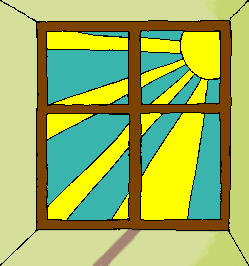 |
You might also have the students experiment with a daymark-system. They don't need to live on Scandinavian farms, they can try them out at their own houses or at school.
First they will need to observe the path of the Sun to find the highest point in the Sun's path. Go outside in the hours around 12 noon for several days to find this time. During Hello, Sun! (and later more mathematically in This is a Stick-Up), the class found out how to record the Sun's path and to find out when it was highest in the sky. All they need do now is find what is on the horizon beneath the Sun when it is in Midday Place at its highest point. There need not be a mountain there--a building, a tree, anything to mark the spot will do. When the ancient Scandinavians didn't have a natural feature to mark the spot for them they would often build a little pile of stones out towards their horizon. Perhaps you can mark the spot with a pole or with colored ribbons. If nothing else, you might have the students draw a large panoramic view of the horizon and draw the Sun's positions on it, marking the Midday daymark.
If you can, have the students note the positions of the Sun at the beginning and end of the school day (probably easier than sunrise and sunset!) at different times during the school year. Perhaps you can find or make various daymarks for the other "eights". You can even have them invent names for times of day which
are meaningful to them: School-Start for the morning and Go-Home for the afternoon, perhaps. Have them see how the daymarks for these times can change over the year, while the Midday daymark stays steady. The same experiments can be done at the
students' own homes as well.
Another project could be making a window Noon Line. This was a device used by farmers in Skåne, Sweden to mark Midday. Find a south-facing window which has several panes of glass. Notice how the solid framework between the panes
casts shadows onto the window sill. When the Sun is at its highest point (at Midday) you can mark the line of the shadow cast by the pane frame with masking tape. This effectively turns the window into a simple sundial. Whenever the shadow of the pane frame matches the line of tape, that means it is Midday.
1 The English word "hour" comes from Middle English houre/oure/ure. These forms were borrowed from Anglo-Norman ure, itself related to Old French ore or oure (Modern French heure) stemming ultimately from Latin hora. Late Latin h had become a silent letter, explaining why it does not appear in the older English or French words for "hour"--it was only added back in modern times, modeled on the classical spelling of Latin hora. The Latin word stems back to a very ancient Indo-European root, jér- or jór-, which had to do with units of time. This same root lead ultimately to the word "year", through a different developmental path. Back to text
2 For convenience, all Scandinavian terms are given in Old Norse (or Old Icelandic), the medieval language from which the modern Scandinavian languages are descended. The equivalent terms in the modern Scandinavian languages have changed very little. Geographical names, however, are written in the language of the named feature's region. Back to text
3
As a translation of átt, a word like "octant" or "octet" might be more appropriate than "eighth". Since the relation of these words to the number eight (8) might not be immediately apparent to students, "eighth" is probably better. It might be mentioned that sometimes this word is spelled ætt, which means "family" (used in the sense that the different directions may be grouped into a "family of directions". It is unsure which term is more correct, but átt and "eighth" are used in this document.
Eykt has a totally different meaning. It is related to the English
word "yoke" (Old Norse eykr), as in the device used in harnessing draft horses or oxen. Draft animals could only be harnessed for a certain length of time before they needed to be rested. Thus, people divided the time of day into segments according to when their animals were yoked. Eventually the eykt referred directly to the unit of time, rather than an actual yoking-period. [Jan de Vries, Altnordisches etymologisches Wörterbuch (Leiden: Brill, 1961).]
Back to text
4 An alternate name is eyktarmark, very commonly used in Iceland. English-speaking students, however, may have an easier time remembering dagmark and its clear relation to English "daymark". Back to text
5
The last character in stað should look like a bent-stem lower-case
 "d" with a bent stem which has been crossed like a lower-case "t". If you are viewing this document on a DOS/Windows machine it should look like that without trouble. If you are using a Macintosh, it may look wrong (like a ">"). Macintoshes need a special font (such as
Times OE)
to display this and other special non-English characters. This character is pronounced like the "th" in words such as "this" or "bathe". It was originally invented by English scribes and was used in writing Old English. It was later adopted by Scandinavian scribes, but eventually fell out of use in English writing.
Back to text
"d" with a bent stem which has been crossed like a lower-case "t". If you are viewing this document on a DOS/Windows machine it should look like that without trouble. If you are using a Macintosh, it may look wrong (like a ">"). Macintoshes need a special font (such as
Times OE)
to display this and other special non-English characters. This character is pronounced like the "th" in words such as "this" or "bathe". It was originally invented by English scribes and was used in writing Old English. It was later adopted by Scandinavian scribes, but eventually fell out of use in English writing.
Back to text
6
For a discussion of eykt, see note 2 above. The
Norwegian word ykt or økt (which is descended from eykt) is often used to refer to lunchtime meal eaten at this time; perhaps if this time of day was a popular lunch break, the general term eykt stuck as a special name for this time.
The term undorn may have also referred to a meal. There was once
a term "undern" in English, though the word largely fell out of use after the 1400s. Strangely, it could mean either a time in the morning or (like the Scandinavian undorn) mid-afternoon. Variants survived in northern British English dialects (in forms like "oanders", "aunders", and "andrum") meaning "afternoon meal" into the late 1800s. In teaching this material, "undern" could be used in place of the Scandinavian word undorn, if desired.
Back to text
7 The English word "noon" has a similar origin, but its time has been transposed to midday! The same shift has happened to Dutch noen and French none (a somewhat archaic term in French, now generally limited to use in certain French dialects). These words also come from Latin nona and originally indicated a time around 3 p.m., but now mean Midday. Back to text
8 The Old Norse word mál is translated here as "measure". It was a word which could be used with a variety meanings, mostly having to with the measuring out of a certain thing. It is related directly to the English word "meal" (as in a time for eating, or food eaten) and can be used in that sense. Back to text
9 There is an English version of the Scandinavian word ótta: ughten. It is obsolete, having largely dropped out of usage after the 1300s. A Scots dialect version of it, "oachenin" was still being used in Caithness, Scotland around 1900. In teaching this material, it could be used in place of the Scandinavian word ótta, however. Back to text
10
Another name often used for Mid-Morning was rismál meaning "Rise-Measure", a name formed like Day-Measure and Night-Measure.
Back to text